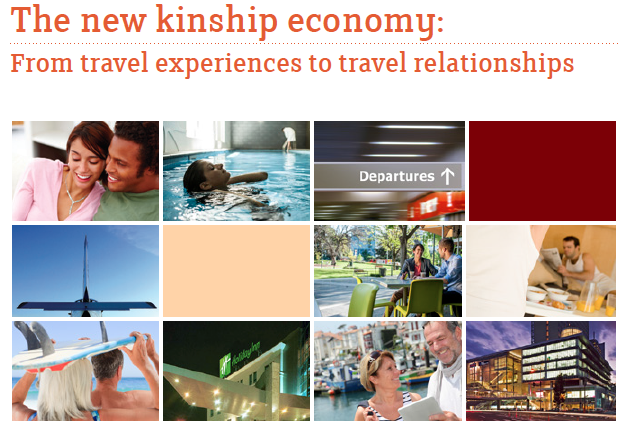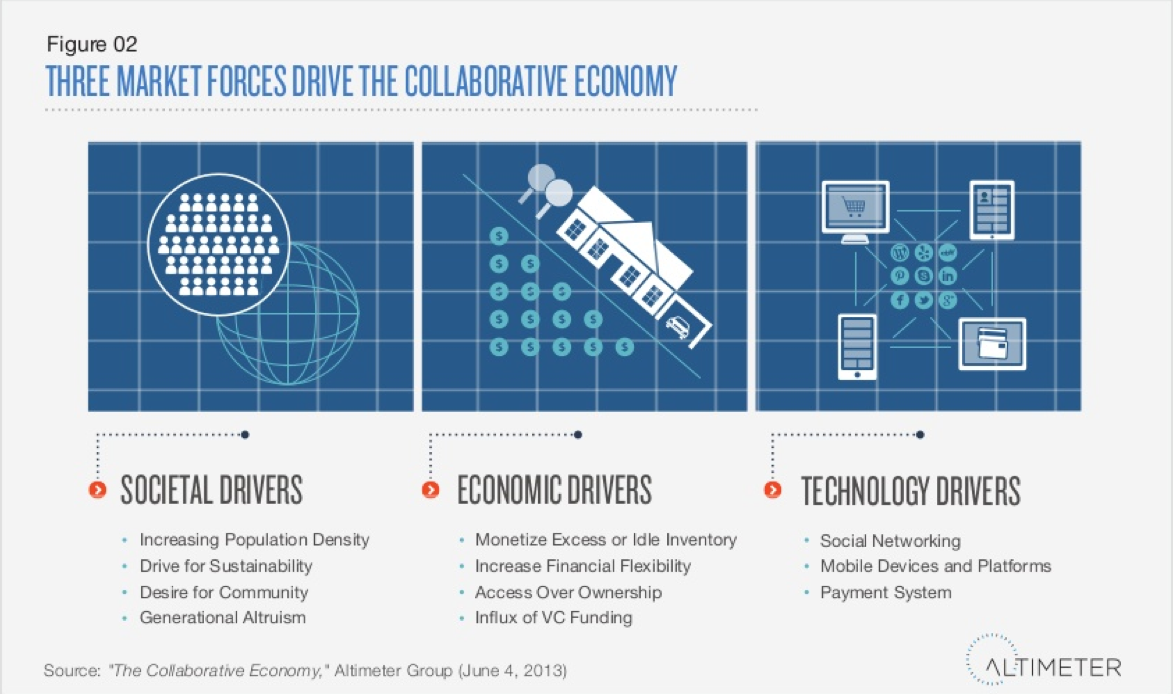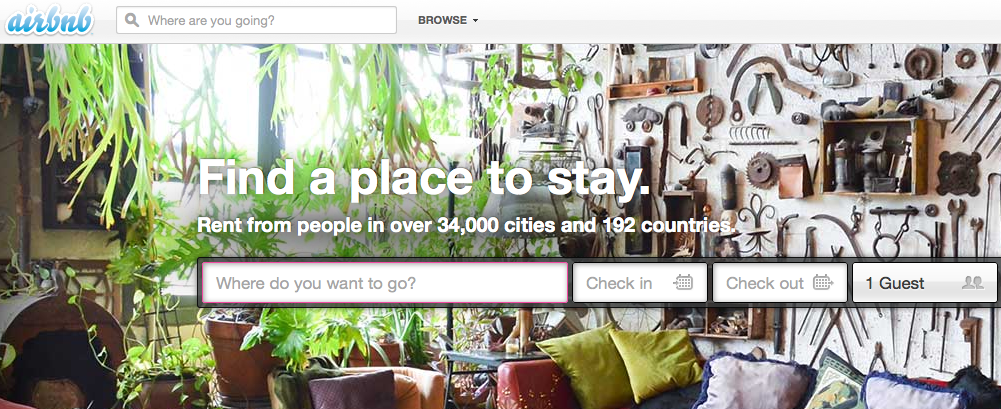What do sites such as AirBnB, Relayrides, Cookening or Vayable have in common? They are all, in their own way and in their own niche, web platforms presently shaking the travel & hospitality industry inside out. It’s a groundswell that few are considering seriously: the collaborative economy.
COLLABORATIVE ECONOMY?
Also known as the peer-to-peer (P2P) movement, the collaborative economy basically stems from technological developments enabling consumers to bypass corporations and big brands to transact directly with each other. According to the Altimeter Group, it can be defined as follows:
The Collaborative Economy is an economic model where ownership and access are shared between corporations, start-ups and people. This results in market efficiencies that bear new products, services and business growth.
While social networks, massive mobile device adoption and easy-to-use websites, blogs and other platforms explain in great part how this new economy is taking shape, there are are also two key market forces driving this movement.
As Jeremiah Owyang explains in this June 2013 report, there are both societal and economical drivers explaining this new economy, as explained in the figure below:
Napster, anyone?
The P2P movement has been making waves for years now, making notorious in-roads within the music industry. Remember when Napster and other public file-sharing sites shook up the traditional models in place some 12-14 years ago?
What happened next is now part of history: music labels fought hard against what was to be a losing battle. Napster ended up folding, but iTunes came around selling individual songs for $0.99. Newer models are taking shape where copyrights are respected, illegal downloads reduced with monthly payments, freemiums or individual payments, i.e. Spotify, Grooveshark, Songza, etc.
AND NOW, THE TRAVEL INDUSTRY…
For many, AirBnB represents the posterchild of collaborative platforms shaking up the traditional hospitality model. Just like Napster ruffled some feathers back in the days, AirBnB is presently the dominant player under public scrutiny in the travel sphere, with some legal woes in the State of New York among other places.
As can be expected, hospitality leaders are responding much the same as major music labels did back in 2001: some deny the phenomenon or are oblivious to its impact while others now want to wage a full-on war on to what is considered “illegal” housing.
The thing is, how do you wage a war on a phenomenon that’s becoming anchored in our everyday life, part of a new, evolving social fabric?
And while there is a lot of talk about AirBnB, Couchsurfing, HomeAway and other vacation rentals sites, the truth is that the P2P movement spreads much deeper and wider than strictly accommodations.
In fact, the collaborative economy is now rooted in each of the five key elements of the travel ecosystem:
GETTING THERE
From car-pooling to renting out your car, there are even sites where you can rent out your driveway as a parking spot downtown or if you happen to live nearby a popular spot, i.e. baseball field, events, venue, etc.
Some examples: AmigoExpress, GetAround, Parkatmyhouse, RelayRide or Zimride.
SLEEPING
You can swap homes with one another, have someone sleep on your couch or living room floor, rent out a room or your entire apartment, rent out occasionally or professionally, downtown or by a lake.
Pretty much anybody who’s got a house or place to live is potential player in this field, really…
Leading examples: AirBnB, Wimdu, Couchsurfing, HomeAway, HomeExchange, HouseTrip, not to mention vacation rentals offered on Tripadvisor (FlipKey) and Booking.com (InterHome).
EATING
We’re starting to see locals prepare home-cooked meals and simply inviting unknown guests to join and mingle away.
Other on-the-road chefs will come over to your house, apartment or chalet and cook a 5-course meal for you and your guest. Or you can rate your favorite local spot to share for everyone’s delight…
Some examples: Cookening, KitchenSurfing, Forkly, Yelp.
VISITING
Once at a destination, instead of waiting in line at the information center, why not ask a local for the best spots, things to do or places to see? Better yet, get your own private guide to show you the off-the-beaten paths stuff and hidden gems that only locals would know about…
Some examples: Vayable, GetYourGuide, LocalGuiding, or SideTour.
THE OVERALL EXPERIENCE
Finally, there are a multitude of side-services to help you have a great experience prior, during or after the trip. Need a babysitter once at the destination, or someone to look after your dog while you’re away?
Perhaps you’d like to rent a kayak, camping tent or generator for the BBQ while at the cottage? Some examples: Zilok, Rover, DogVacay, Uniiverse, or CanaryHop.
Notice that most, if not all, of the above experiences and services providers would traditionally be paying members of destination marketing organizations (DMO) or conventions & visitors bureau (CVB).
Thus, this major shift under way is one of the key disruptors explaining Why the DMO model is broken and how it will need to adapt to this new reality.
AND IT’S BIG BUSINESS TOO!
But just how much money does this new economy represent and how is it impacting the traditional players? A recent analysis by EuroMonitor International contends the impact of AirBnB on the hotel industry is minimal.
Considering AirBnB has sold 10 million room nights since its inception in 2007 pales by comparison to the one billion room nights sold in the US alone, only in 2012! Perhaps, but I still believe there is a major shift going on here that WILL impact traditional hotel players.
Here are a few reasons why:
- AirBnB is not the only player out there with its 300,000 listings. In fact it’s not even the biggest. HomeAway, part of the VRBO family (Vacation Rentals By Owners), is said to have over 500,000 listings, while FlipKey has over 170,000 listings and InterHome holds on to more than 260,000 listings. If you add up listings from other popular sites like Wimdu, HouseTrip or Roomarama, not to mention all the other smaller sites or even independent property owners who distribute their offerings through popular sites like craigslist, then you start to paint quite a different, more complex picture.
- There are many who think listings on these sites are mostly made of everyday John Smith and Jane Doe, renting out occasionally to help with the monthly rent. Truth is, it’s estimated only 28% of offerings come from such people, who don’t do this professionally. In other words, 72% of listings come from property owners who often manage multiple listings.
- According to the 2012 Summer VRM Owners report, vacation rental owners generate an average of about $26,000 per year in rental income.
- In fact, the vacation rentals market is estimated to be worth US$85 billion in North America and Europe alone, and growing…
And just like the Hygrade sausage principle, the more people will talk about this different way to travel and book accommodations, the more it will add to its credibility and popularity, turning it into an even greater threat than it is now.
WHAT CAN HOTELS DO?
 Acknowledging the present situation and shift in consumer behavior would have to be the very first step, yet few hotels publicly call it out or seem to revamp their customer experience accordingly.
Acknowledging the present situation and shift in consumer behavior would have to be the very first step, yet few hotels publicly call it out or seem to revamp their customer experience accordingly.
A study by InterContinental Hotels Group (IHG), The New Kinship Economy, published earlier this year, spoke of new travel relationships, the evolving digital landscape and different styles of travelers, from multi-generational to new family groups.
Changes, changes
Well I wonder… do these new types of travelers find what they need in hotels that have not changed their offering in the past decade, if not more? Some of the irritants from traditional hotel business include:
- Prohibitive costs for a local phone call
- Prohibitive costs for breakfast or most in-room dining options (when breakfast is not included, of course)
- Ridiculous prices for anything found in the mini-bar – which you’ll find across the street for 10 times less…
- Uneven wifi access, performance and access costs
All things we’d take for granted a few years ago, but does it still fly in 2013? Independent hoteliers or hotel chains nimble enough to adapt are those who will maintain their market share and grow.
A great example is how Kimpton Hotels, in the US, focus on customer service with various surprise & delight initiatives that keep customers coming back. Or Hilton’s Garden Inn brand, offering suites and full-kitchen amenities catering to families or customers staying longer. And there are many more, of course.
The collaborative economy is here to stay and will impact many aspects of our everyday life, including how we travel and discover the world. Hurdles still remain to ensure proper standards are delivered across all experiences and to avoid illegal encounters.
But denying this phenomenon won’t help, nor battling it with hopes that it shall go away. It’s time to embrace the potential and see how it can become beneficial to all in the travel industry, starting with the consumer. Because after all, hoteliers who always had and still have the customer as their number one focus need not fear for the future…












Leave a Reply